



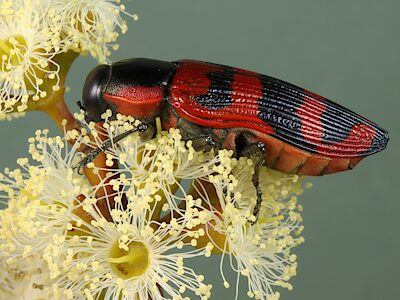

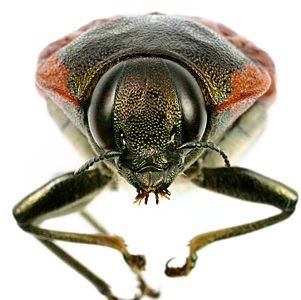


Actual
size¹:
size¹:
25.7 mm
×
10.2 mm
×
10.2 mm









| male | female | |||||
|---|---|---|---|---|---|---|
| L1 | 23.7 | 18.3 – 28.5 | n = 19 | 27.6 | 20.1 – 32 | n = 20 |
| L2 | 23.4 | 18.2 – 27.4 | n = 19 | 26.9 | 19.7 – 31.5 | n = 19 |
| W | 9.2 | 7.05 – 10.9 | n = 19 | 11.2 | 7.5 – 13.1 | n = 20 |
| Legend | L1 | length from clypeus/frons to elytral apex (mean, range, sample size) |
| L2 | length from anterior of edge of eyes to elytral apex | |
| W | maximum width with elytra fully closed |
| Legend | P.J.Lang collection vouchered records | |
| other private collection or museum specimens, or sightings |
|
|
|
|
|
|
|
|
|
|
|
|
|
||||||||||||||||||||||||||||||||||||||||||||||||
|
|
|
|
|
|
|
|
|
|
|
|
|
||||||||||||||||||||||||||||||||||||||||||||||||
|
|
|
|
|
|
|
|
|
|
|
|
|
||||||||||||||||||||||||||||||||||||||||||||||||
| Jul | Aug | Sep | Oct | Nov | Dec | Jan | Feb | Mar | Apr | May | Jun |
| Legend | ||
9 | number of active beetles, actually recorded in that quarter-month | |
2 | estimate of active beetles, inferred* from adjoining date ranges | |
| actual count > 4 (median) | ||
| actual count <= 4 (median) | ||
| live non-emerged (inactive) beetles only | ||
| *Inferred when a site has counts of active beetles for each of two consecutive
periods (date ranges), one finishing and the other starting in the same
quarter-month. The count estimate is assigned to that quarter-month and calculated as the lower of the two total beetle counts, divided by the number of quarter-months in its date range. | ||
| beetles | sites | SA regions¹ | family | position on host plant | |||
| Eucalyptus leptophylla | 6 | 4 | EP, MU, SE | M | |||
| Bursaria spinosa ssp. spinosa | 2 | 2 | SL | P1 | |||
| Eucalyptus porosa | 2 | 1 | SE | M | |||
| Allocasuarina muelleriana ssp. muelleriana | 2 | 2 | MU, SL | C | |||
| Choretrum glomeratum | 2 | 2 | SL, SE | S | |||
| Eucalyptus socialis | 2 | 1 | SE | M | |||
| Allocasuarina muelleriana ssp. notocolpica | 1 | 1 | KI | C | |||
| Cassinia complanata | 1 | 1 | YP | A | |||
| Darwinia micropetala | 1 | 1 | KI | M | |||
| Hakea mitchellii | 1 | 1 | KI | P2 | |||
| Xanthorrhoea semiplana ssp. tateana | 1 | 1 | KI | X |
| Legend | beetles | count of beetles collected from, or sighted on, host plant taxon |
| sites | count of major sites (unique 10 km grid cells +/- some distinct approximate localities) | |
| Plant names in green are hyperlinked to a matching host species page with plant photos. | ||
| Code | beetles | % | host plant taxa | |
| M | Myrtaceae | 11 | 52% | 4 |
| C | Casuarinaceae | 3 | 14% | 2 |
| P1 | Pittosporaceae | 2 | 10% | 1 |
| S | Santalaceae | 2 | 10% | 1 |
| A | Asteraceae | 1 | 5% | 1 |
| P2 | Proteaceae | 1 | 5% | 1 |
| X | Xanthorrhoeaceae | 1 | 5% | 1 |
| position | beetles | sites | ||
| on flower(s) | 7 | 4 | ||
| on flowering plant | 4 | 2 | ||
| on foliage or non-flowering plant | 2 | 2 | ||
| on dead foliage | 1 | 1 | ||
| on plant (unspecified) | 5 | 5 | ||
| other | ||||
| hovering over | 1 | 1 | ||
| on stem | 1 | 1 | ||
| colour | beetles | sites | SA regions¹ | |
| white | 85 | 3 | SE | |
| light pink | 23 | 2 | SE | |
| blue | 20 | 3 | KI, SE | |
| bright green | 5 | 2 | SE | |
| yellow | 1 | 1 | SE |
 15 cm out from stem base & frass, SE, photo by A.M.P. Stolarski, L1_x300.jpg)
 horizontal root, SE, photo by A.M.P. Stolarski, L2_x300.jpg)



, L6_x300.jpg)
, L7_x300.jpg)
, L8_x300.jpg)
, L9_x300.jpg)
 root crown, SE, photo by A.M.P. Stolarski, L10_x300.jpg)
, in EtOH (dorsal), SE, L11_x300.jpg)
, L12_x300.jpg)
, L13_x300.jpg)
, L14_x300.jpg)


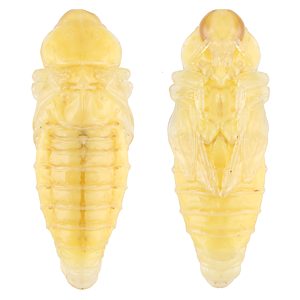

 horizontal root with frass plug, SE, photo by A.M.P. Stolarski, P5_x300.jpg)
 horizontal root, SE, photo by A.M.P. Stolarski, P6_x300.jpg)

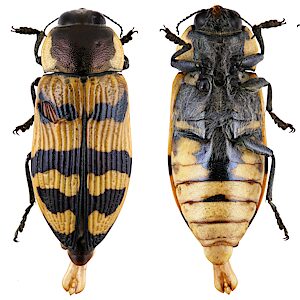

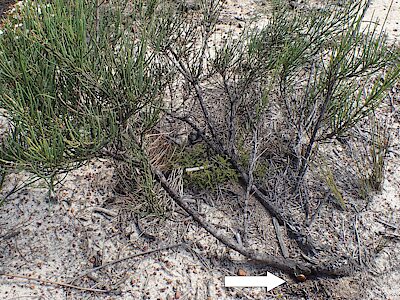
, KI, photo by Mark Hura, B3_x300.jpg)

| records | sites | SA regions¹ | family | adult dead | adult ex pupa | pupa | pupa ex larva | larva | |
| Allocasuarina muelleriana ssp. muelleriana | 22 | 3 | SL, SE | C | 1 | 3 | 3 | 1 | 14 |
| Legend | records | count of breeding adults, pupae and larvae |
| sites | count of major sites (unique 10 km grid cells +/- some distinct approximate localities) | |
| adult | live = extracted alive; dead = extracted dead as intact or fragmentary remains; ex billet = reared and emerged from stored sections of host; ex pupa = reared from sampled pupa | |
| pupa | extracted pupa; pupa ex larva = reared pupa from larva | |
| larva | extracted larva (any stage including prepupa) | |
| gall (only) | hatched or unhatched gall identified by form and position rather than contents | |
| Plant names in green are hyperlinked to a matching host species page with plant photos. | ||
| Code | records | % | host plant taxa | |
| C | Casuarinaceae | 22 | 100% | 1 |
| position | records | sites | adult dead | adult ex pupa | pupa | pupa ex larva | larva | |
| root | 15 | 2 | 3 | 2 | 1 | 9 | ||
| root crown | 1 | 1 | 1 | |||||
| stem base | 1 | 1 | 1 | |||||
| stem | 4 | 1 | 4 | |||||
| dead stem | 1 | 1 | 1 |
A.M.P. Stolarski discovered this species breeding in the roots and lower parts of Slaty Oak-bush (Allocasuarina muelleriana ssp. muelleriana) at two sites in the upper South-eastern Region. I found remains of a dead non-emerged adult in the base of a dead trunk of the same plant taxon on upper Fleurieu Peninsula. An amazing iNaturalist observation by M.A. Hura shows a female T. mitchellii excavating below the basal stem and apparently ovipositing on the Kangaroo Island subspecies, A. muelleriana ssp. notocolpica (see images above).
| ¹ Legend | regions | SA State Herbarium regions (map) EA: Eastern, EP: Eyre Peninsula, FR: Flinders Ranges, GT: Gairdner-Torrens, KI: Kangaroo Island, LE: Lake Eyre, MU: Murray, NL: Northern Lofty, NU: Nullarbor, NW: North-Western, SE: South-Eastern, SL: Southern Lofty, YP: Yorke Peninsula |
| size | The ellipse is the correct size when printed, indicative on a desktop screen, and likely to be wrong on a mobile device. |